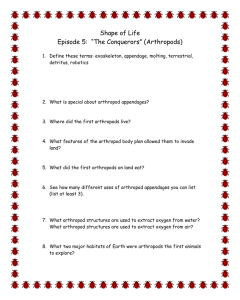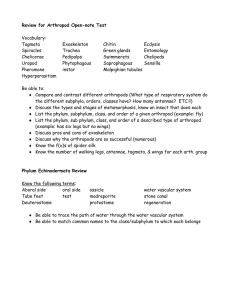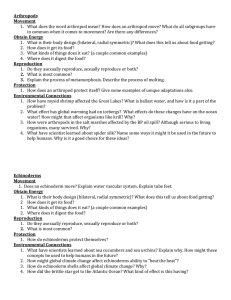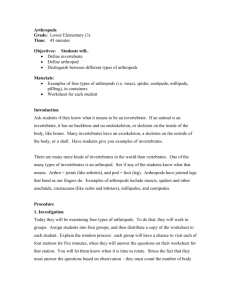Arthropods of Native and Exotic Vegetation and Their Association with Willow
advertisement
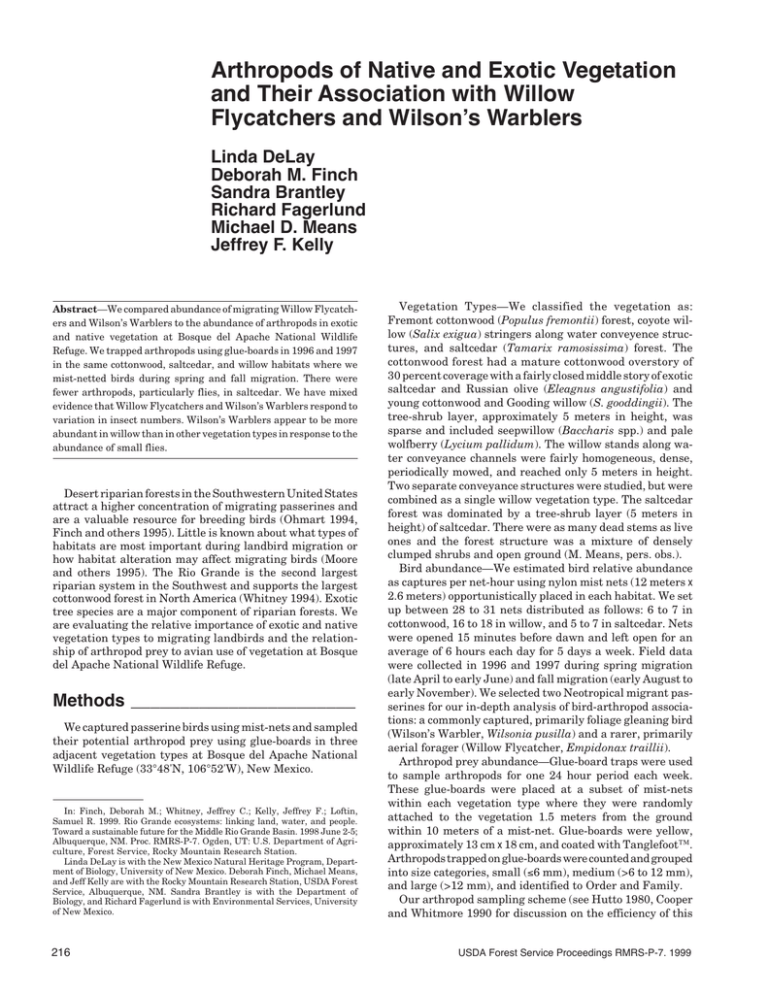
Arthropods of Native and Exotic Vegetation and Their Association with Willow Flycatchers and Wilson’s Warblers Linda DeLay Deborah M. Finch Sandra Brantley Richard Fagerlund Michael D. Means Jeffrey F. Kelly Abstract—We compared abundance of migrating Willow Flycatchers and Wilson’s Warblers to the abundance of arthropods in exotic and native vegetation at Bosque del Apache National Wildlife Refuge. We trapped arthropods using glue-boards in 1996 and 1997 in the same cottonwood, saltcedar, and willow habitats where we mist-netted birds during spring and fall migration. There were fewer arthropods, particularly flies, in saltcedar. We have mixed evidence that Willow Flycatchers and Wilson’s Warblers respond to variation in insect numbers. Wilson’s Warblers appear to be more abundant in willow than in other vegetation types in response to the abundance of small flies. Desert riparian forests in the Southwestern United States attract a higher concentration of migrating passerines and are a valuable resource for breeding birds (Ohmart 1994, Finch and others 1995). Little is known about what types of habitats are most important during landbird migration or how habitat alteration may affect migrating birds (Moore and others 1995). The Rio Grande is the second largest riparian system in the Southwest and supports the largest cottonwood forest in North America (Whitney 1994). Exotic tree species are a major component of riparian forests. We are evaluating the relative importance of exotic and native vegetation types to migrating landbirds and the relationship of arthropod prey to avian use of vegetation at Bosque del Apache National Wildlife Refuge. Methods _______________________ We captured passerine birds using mist-nets and sampled their potential arthropod prey using glue-boards in three adjacent vegetation types at Bosque del Apache National Wildlife Refuge (33°48'N, 106°52'W), New Mexico. In: Finch, Deborah M.; Whitney, Jeffrey C.; Kelly, Jeffrey F.; Loftin, Samuel R. 1999. Rio Grande ecosystems: linking land, water, and people. Toward a sustainable future for the Middle Rio Grande Basin. 1998 June 2-5; Albuquerque, NM. Proc. RMRS-P-7. Ogden, UT: U.S. Department of Agriculture, Forest Service, Rocky Mountain Research Station. Linda DeLay is with the New Mexico Natural Heritage Program, Department of Biology, University of New Mexico. Deborah Finch, Michael Means, and Jeff Kelly are with the Rocky Mountain Research Station, USDA Forest Service, Albuquerque, NM. Sandra Brantley is with the Department of Biology, and Richard Fagerlund is with Environmental Services, University of New Mexico. 216 Vegetation Types—We classified the vegetation as: Fremont cottonwood (Populus fremontii) forest, coyote willow (Salix exigua) stringers along water conveyence structures, and saltcedar (Tamarix ramosissima) forest. The cottonwood forest had a mature cottonwood overstory of 30 percent coverage with a fairly closed middle story of exotic saltcedar and Russian olive (Eleagnus angustifolia) and young cottonwood and Gooding willow (S. gooddingii). The tree-shrub layer, approximately 5 meters in height, was sparse and included seepwillow (Baccharis spp.) and pale wolfberry (Lycium pallidum). The willow stands along water conveyance channels were fairly homogeneous, dense, periodically mowed, and reached only 5 meters in height. Two separate conveyance structures were studied, but were combined as a single willow vegetation type. The saltcedar forest was dominated by a tree-shrub layer (5 meters in height) of saltcedar. There were as many dead stems as live ones and the forest structure was a mixture of densely clumped shrubs and open ground (M. Means, pers. obs.). Bird abundance—We estimated bird relative abundance as captures per net-hour using nylon mist nets (12 meters x 2.6 meters) opportunistically placed in each habitat. We set up between 28 to 31 nets distributed as follows: 6 to 7 in cottonwood, 16 to 18 in willow, and 5 to 7 in saltcedar. Nets were opened 15 minutes before dawn and left open for an average of 6 hours each day for 5 days a week. Field data were collected in 1996 and 1997 during spring migration (late April to early June) and fall migration (early August to early November). We selected two Neotropical migrant passerines for our in-depth analysis of bird-arthropod associations: a commonly captured, primarily foliage gleaning bird (Wilson’s Warbler, Wilsonia pusilla) and a rarer, primarily aerial forager (Willow Flycatcher, Empidonax traillii). Arthropod prey abundance—Glue-board traps were used to sample arthropods for one 24 hour period each week. These glue-boards were placed at a subset of mist-nets within each vegetation type where they were randomly attached to the vegetation 1.5 meters from the ground within 10 meters of a mist-net. Glue-boards were yellow, approximately 13 cm x 18 cm, and coated with Tanglefoot™. Arthropods trapped on glue-boards were counted and grouped into size categories, small (≤6 mm), medium (>6 to 12 mm), and large (>12 mm), and identified to Order and Family. Our arthropod sampling scheme (see Hutto 1980, Cooper and Whitmore 1990 for discussion on the efficiency of this USDA Forest Service Proceedings RMRS-P-7. 1999 method) was set up primarily for ease of operation and to estimate general abundance of arthropods in relation to the relative abundance of birds captured in the immediate vicinity. With this single sampling method, we do not claim to be sampling the same prey species that aerial gleaning and foliage gleaning insectivores are capturing. We are assuming that prey numbers correlate with those of arthropod availability. For a more adequate picture of availability (see Hutto 1985), we incorporated differences in vegetation density (foraging-substrate availability) among vegetation types into our estimates of arthropod availability. Assuming independence of arthropods captured and vegetation density between vegetation types, we calculated a relative index of arthropod numbers adjusted by a measure of shrub density (<5 meters in height). We calculated the average number of shrub stems for a habitat from 0.04 ha areas around each net and divided the number by 1000. We then multiplied that vegetation density by the number of arthropods per trap. Analysis—Statistical analyses were performed with SPSS/ PC+ (SPSS 1994) or SAS/PC (SAS Institute 1990). Normality and homogeneity were examined prior to applying parametric and nonparametric tests. Univariate analysis of variance was performed using PROC GLM (SAS Institute 1990) to test for differences in arthropod abundances among vegetation types for each year and season. Numerically important orders of arthropods were identified, and separate ANOVA tests were performed for each group. Duncan’s multiple range test was used to determine which mean values from each vegetation type were different, and Bonferroni adjustments in significance levels were made when needed (Rice 1989). The arthropod count data were log-transformed for the ANOVA tests. Associations between arthropod abundance and bird abundance were tested with the nonparametric Spearman’s rank correlation test (SPSS 1994). A Wilcoxon 2-tailed test was used to examine differences in two size classes of flies. An alpha level of 0.05 was used to signify significance. Results ________________________ Fifteen orders of arthropods were represented on glueboards set out in cottonwood midstory, stands of willow, and stands of saltcedar forest. Coleopteran, Dipteran, Hemipteran, Homopteran, Hymenopteran, and adult Lepidopteran were represented in samples in both seasons and years in all three habitats (table 1). There were significant year and season differences among the relative abundances of insects (2-way ANOVA: F=1.24, df= P=0.002) and the seasonal difference depended on the year (year*season, F=9.24, df= P=0.003). Subsequent comparisons between vegetation types were therefore examined separately by year and season. The relative abundance of arthropods was significantly less in saltcedar than in willow or cottonwood midstory in most years and seasons. Arthropod numbers per trap were highly variable in saltcedar during fall, 1997, and did not differ from those in willow or cottonwood (fig. 1, table 2). Patterns in the data differed when we corrected arthropod abundance for shrub density (arthropod-shrub index, table 2). There were significantly fewer arthropods (arthropod-shrub index) in the cottonwood understory than in willow for most comparisons. Flies were less abundant in the homogenous stands of saltcedar than in the other vegetation for both years and seasons. There were more orders (5 out of 6) in the fall of 1997, in which differences among vegetation were evident (table 2). Beetles (Coleoptera) and plant bugs (Homoptera) are primarily foliage inhabiting insects and made up the largest proportion (83 percent in 1996 and 77 percent in 1997) of that group. Flies (Diptera) and wasps, etc. (Hymenoptera) made up the greatest proportion of aerial insects (99 percent, both 1996 and 1997). We examined the association of both aerial insects (flies and wasps) and foliage insects (beetles and plant bugs) with Wilson’s Warblers (WIWA) and Willow Flycatchers (WIFL) over time for 1996 and 1997. Over time there was a positive association between the relative Table 1—Orders of arthropods represented by season (S=spring, F=fall) in the three habitats sampled, 1996 and 1997. Order ACARINA (mites) ARANEIDA (spiders) COLEOPTERA (beetles) DERMAPTERA (earwigs) DIPTERA (flies) EPHEMEROPTERA (mayflies, etc.) HEMIPTERA (true bugs) HOMOPTERA (plant bugs) HYMENOPTERA (wasp, etc.) LEPIDOPTERA (adult butterflies,etc.) ODONATA (dragonflies, etc.): ORTHOPTERA (grasshoppers, etc.): THYSANURA (bristletails): THYSANOPTERA (thrips): TRICHOPTERA (caddisflies): USDA Forest Service Proceedings RMRS-P-7. 1999 Cottonwood 1996 1997 Willow 1996 1997 Saltcedar 1996 1997 SF SF F SF SF SF SF SF SF SF SF SF SF SF SF SF SF F SF F SF SF F SF SF F SF SF SF SF SF SF SF SF SF SF SF SF SF SF SF SF F F SF F SF SF SF SF S SF SF F SF SF SF SF SF SF S SF SF 217 Figure 1—The mean relative abundance of all arthropods found in three vegetation types during spring and fall, 1996 and 1997. abundance of Willow Flycatchers and the relative abundance of aerial insects in 1996 (Spearman’s rho 0.89, P=0.001, N=9) but not in 1997 (Spearman’s rho 0.12, P=0.60, N=15). In spring of 1997, WIFL numbers tended to correspond with that of aerial insects, although this pattern was not significant (Spearman’s rho 0.7, P=0.17, fig. 2). Wilson’s Warblers were not associated with aerial insects over all weeks sampled in 1996 (Spearman’s rho 0.42, P=0.26, N= 9) and tended to show only a trend in 1997 (Spearman’s rho 0.50, P=0.06, N=15). However, Wilson’s Warbler numbers appeared to respond to temporal changes in aerial and foliage insect numbers over the spring season of both years (fig. 3). There was a positive association between their relative abundance with that of aerial (Spearman’s rho= 0.90, P=0.04, N=5) and foliage (Spearman’s rho= 0.99, P=0.0001, N=5) insects in the spring. Wilson’s Warbler numbers showed a corresponding association with aerial insects only in the willows in 1997 (Spearman’s rho= 0.65, P=0.009, N=15). There were significantly more small flies (<6mm) than mid to large flies (> 6mm) in the willows in 1997 (Wilcoxon 2-tailed, P=0.0001). The greatest proportion of small flies consisted of Humpbacked flies (Phoridae) and Long-legged flies (Dolichopodidae); flies that tend to hover about the foliage. Together 218 they comprised 31 percent of flies in the spring and increased to 67 percent in the fall. Gnats, chironomids, mosquitoes and other swarming nematocerans comprised 61 percent of the flies in spring and dropped to 19 percent in the fall. Discussion _____________________ Migration is energetically stressful and migrants must stopover between breeding and wintering habitats to forage, rest, and replenish fat deposits (Moore and others 1995). Decisions involved in habitat selection by landbird migrants may depend on the spatial scale examined. The decision to stop along a particular route on the way between wintering and breeding grounds may be driven by such extrinsic factors as genetics or associated with the benefits of the shortest distances and most favorable wind patterns. Selection of a particular habitat may occur once migrants settle in an area and may involve intrinsic factors such as characteristics of that vegetation type or habitat (for review see: Hutto 1985a and Moore and others 1995). Physical structure of the habitat, including plant species composition and foliage density, may influence how birds move through the habitat, see and capture prey, and may determine how susceptible USDA Forest Service Proceedings RMRS-P-7. 1999 Table 2—Comparisons, between habitats at a different year and season, of relative abundance of arthropods and an index of arthropod abundance adjusting for shrub density. ANOVA results using logtransformed data. Duncan groupings provide comparisons of each habitat (C = Cottonwood, S = Salt Cedar, W = Willow). Letters not underscored by the same line are significantly different. Asterisks denote that significance (P < 0.05) remains and ns denotes its removal after a sequential bonferroni adjustment. N = no. weeks All individuals Spring 1996 Fall 1996 Spring 1997 Fall 1997 3 5 5 10 Arthropod numbers/trap Duncan Groups: ANOVA High mean to P value Low mean 0.0001 0.0001 0.001 0.014 W C W W C W C S S S S C Arthropod-Veg Indexa Duncan Groups: ANOVA High mean to low P value mean 0.0001 0.0001 0.0004 0.0001 Spring 1996 Beetles Flies True Bugs Plant Bugs Wasps, etc. Thrips Six top ranking Orders (abundance of individuals) 0.039ns 0.001* W C S 0.0005* W S C 0.068 0.002* W C S 0.237 Fall 1996 Beetles Flies True Bugs Plant Bugs Wasps, etc. Thrips Six top ranking Orders (abundance of individuals) 0.62 0.0002* C W S 0.278 0.046ns 0.03ns 0.301 Spring 1997 Beetles Flies True Bugs Plant Bugs Wasps, etc. Thrips Six top ranking Orders (abundance of individuals) 0.002* C W S 0.001* W C S 0.552 0.012* W C S 0.08 0.353 Fall 1997 Beetles Flies True Bugs Plant Bugs Wasps, etc. Thrips Six top ranking Orders (abundance of individuals) 0.0001* C W S 0.0001* W C S 0.0001* W S C 0.009* W S C 0.0001* W C S 0.759 a W S W S W S S W C C C C Arthropod-veg index = (number arthropod individuals/trap)* number shrub stems. migrants are to predation (Robinson and Holmes 1982, 1984). Several studies indicate a relationship exists between food availability and avian selection of different habitats (reviewed in Moore and others 1995). We examined measures of arthropod availability of cottonwood habitat, stands of willow and stands of exotic saltcedar. We found a difference among arthropod orders and their abundance among vegetation types. Typically, saltcedar harbored fewer total arthropods, particularly flies, compared to the cottonwood understory, and willow stands. When we extrapolated from numbers of arthropods caught on traps to what might be available on the vegetation by using a shrub density index, we instead found fewer USDA Forest Service Proceedings RMRS-P-7. 1999 arthropods in the cottonwood midstory. This pattern might be explained by the fact that the cottonwood midstory, a large portion of which is saltcedar, is less dense than that of the monotypic saltcedar stand. In the future we plan to include vegetation species diversity and spatial aspects of vegetation to refine the relationship of arthropods to our vegetation types. Sudbrock (1993) stated that arthropod populations on individual saltcedar plants fluctuate more in saltcedar monocultures than in mosaics of native vegetation. Those fluctuations may have negative impacts on wildlife that feed on arthropods. Contrary to what several other authors have reported (Cohen and others 1978 and Crawford and others 219 Figure 2—The relationship of Willow Flycatchers with that of aerial insects (Orders: Dip=Diptera, Hym=Hymenoptera) over time in 1997 1993), Mund-Meyerson and others (in Mund-Meyerson, 1998) report that arthropod density on saltcedar, based on fogging tree canopies, was not significantly different from cottonwood trees over most of the breeding season of migrant birds (May, June, and August samples). Our arthropod sampling in cottonwood habitat included only midstory trees and shrubs: saltcedar, Russian olive, and cottonwood. In order to evaluate possible migrant bird selection of exotic and native habitats during their migration, we need to examine more components of each habitat that may influence prey availability. These elements would include arthropod abundance and diversity in relation to both overstory and understory layers of a habitat (structural complexity), plant or arthropod species diversity of a habitat, and vegetation density. These factors may influence numbers of arthropods as well as their accessibility to avian predators. We will also incorporate information on foraging behaviors within our habitat designations in order to aid our evaluation and interpretation of vegetation use. Our data suggest that migrating Wilson Warblers (WIWA) and, perhaps, Willow Flycatchers (WIFL) respond to variation in arthropod abundance over time, especially during spring migration. There was an association of WIWA capture rates with both aerial and foliage insects over time. WIWA capture rates were associated with aerial insects in the willows in 1997. The association of WIFL capture rates with aerial insects was weak. Future analyses will examine the correlation of bird capture rates to those of arthropods on a net-to-trap basis. After completing our identification of glue-board arthropods for 1996 and sampling from 1998, we will have a more comprehensive data set from which to evaluate bird-arthropod associations in each of our habitat categories. Depending on the migrant species, different taxa of arthropods may determine avian vegetation use. Our future analyses will include the examination of different families of arthropods and their association to migrant capture rates within each vegetation type. Raley and Anderson (1990) 220 found, for example, that riparian birds, one of which was the WIWA, selected arthropod prey disproportionately to availability in willow. They also found that very small arthropods were consistently underrepresented in WIWA diets. We found an association with insect abundance and WIWA in willow and hypothesize that this association may be in response to a similar temporal change in abundance of small dipterans such as gnats and chironomids. We need to examine data on avian prey-foraging behavior and prey selection within each vegetation type to better understand possible factors underlying vegetation and habitat use. One school of thought suggests that food is only loosely exploited and is not important in determining bird species abundance (Wiens 1981); one might only expect a close association between bird population densities and food resource levels during times of resource shortages (Wiens 1977). However, Hutto (1985b) found that insectivorous migratory bird densities matched insect densities across habitats within a season and across seasons within a habitat during years with normal rainfall and thus probably not at a time of resource stress. We speculate that migrant birds at Figure 3—The relationship of Wilson’s Warbler with that of aerial insects (Orders: Dip=Diptera, Hym=Hymenoptera) and foliage insects (Orders: Col=Coleoptera, Hom=Homoptera) over time in 1997. Asterisks denote a significant (*P=0.04, **P=0.0001) association between bird abundance and aerial insect abundance in spring. USDA Forest Service Proceedings RMRS-P-7. 1999 Bosque del Apache Wildlife Refuge may have been resourcestressed on a large scale, in relation to arthropod numbers, in 1997. Fires in the summer of 1996 reduced a large proportion of riparian habitat at the refuge (J. Taylor, pers. comm.) and consequently would have reduced larger-scale availability of foraging habitat and arthropod prey. Capture rates of birds netted at the same sites have decreased during the two years following the fire (J. Kelly, pers. obs.). Weekly relative abundances of arthropods trapped on glue-boards were lower in 1997 than in 1996 (L. DeLay, pers. obs.). Perhaps less available foraging habitat caused migrating insectivores to disperse over a larger area in search of insect prey, and those stopping over at our sites were more responsive to differences in arthropod abundances. It has been suggested that migrants assess alternative habitats during an initial exploratory phase shortly after arrival (Moore and others 1990) and possible cues to prey availability may be feeding activity or high numbers of other migrant birds in the vegetation (Moore and others 1995). Perhaps, there were sufficient numbers of WIWA arriving weekly in our netting area during spring to respond to greater concentrations of other WIWA feeding in willow vegetation. Even though WIFL capture rates were greatest in willow (Kelly and others 1997), their relatively few numbers may be an insufficient cue to feeding activity. Acknowledgments ______________ We thank J. Taylor, P. Norton and the staff of Bosque del Apache National Wildlife Refuge for access, housing, and assistance with our migratory bird studies. We thank Wang Yong for assistance in developing the bird and arthropod sampling methods. We thank our crew leader, D. Hawksworth, and crew members for work and data entry for 1996 and 1997: S. Allerton, L. Balin, G. Bodner, M. Connolly, C. Mandras, and B. Rasch. We also thank Earthwatch International for supplying us with a volunteer workforce in 1997. References _____________________ Cohen, D.R., R.D. Ohmart, and B.W. Anderson. 1978. Avian population responses to saltcedar along the lower Colorado river. USDA Forest Service General Technical Report WO-12:371-382. Crawford, C.S., A.C. Cully, R. Leutheuser, M.S. Sifuentes, L.H. White, and J.P. Wilber. 1993. Middle Rio Grande ecosystems: Bosque biological management plan. US Fish and Wildlife Service, District 2, Albuquerque, NM. USDA Forest Service Proceedings RMRS-P-7. 1999 Hutto, R.L. 1985a. Habitat selection by nonbreeding, migratory land birds. In M. Cody, ed., Habitat Selection in Birds. Academic Press, New York. Hutto, R.L. 1985b. Seasonal changes in the habitat distribution of transient insectivorous birds in southeastern Arizona: competition mediated? Auk 102: 120-132. Finch, D.M., G.L. Wolters, W. Yong, and M.J. Mund. 1995. Plants, arthropods, and birds of the Rio Grande. In D.M. Finch and J.A. Tainter, technical eds., Ecology, Diversity, and Sustainability of the Middle Rio Grande Basin. USDA Forest Service General Technical Report 268:133-164. Kelly, J.K., D.M. Finch, and M.D. Means. 1997. Annual report on bird migration along the low flow conveyance channel in the Bosque del Apache NWR. Prepared for: The Bureau of Reclamation and The Bosque del Apach NWR. Mund-Meyerson, M.J. 1998. Arthropod abundance and composition on native vs. exotic vegetation in the Middle Rio Grande riparian forest as related to avian foraging. Master’s Thesis. Department of Biology, The University of New Mexico, Albuquerque, NM. Moore, F.R., P. Kerlinger, and T.R. Simons. 1990. Stopover on a Gulf coast barrier island by spring trans-Gulf migrants. Wilson Bulletin 102: 487-500. Moore, F.R., S.A. Gauthreaux, P. Kerlinger, and T.R. Simons. 1995. Habitat requirements during migration: important link in conservation. In T.E. Martin and D.M. Finch, eds., Ecology and Management of Neotropical Migratory Birds: a synthesis and review of critical issues. Oxford Univ. Press. Ohmart, R.D. 1994. The effects of human-induced changes on the avifauna of western riparian habitats. Studies in Avian Biology 15:273-285. Raley, C.M. and S.H. Anderson. 1990. Availability and use of arthropod food resources by Wilson’s Warblers and Lincoln’s Sparrows in southeastern Wyoming. Condor 92:141-150. Rice, W. 1989. Analyzing tables of statistical tests. Evolution 43: 223-225. Robinson, S.K. and R.T. Holmes. 1982. Foraging behavior of forest birds: the relationship among search tactics, diet, and habitat structure. Ecology 63: 1918-1931. Robinson, S.K. and R.T. Holmes. 1984. Effect of plant species and foliage structure on the foraging behavior of forest birds. Auk 101: 672-684. SAS Institute. 1995. Statistical Analysis Systems, version 7. SAS Institute Inc. Cary, North Carolina. SPSS Inc. 1994. SPSS/PC+. Marija J. Norusis/SPSS Inc. Chicago, Illinois. Sudbrock, A. 1993. Tamarisk Control I. Fighting back: An overview of the invasion, and a low-impact way of fighting it. Restoration and Management Notes 11(1): 31-34. Whitney, J.C. 1996. The Middle Rio Grande: Its ecology and management. Pp. 4-21 In D. Shaw and D.M. Finch, tech eds., Desired Future Conditions for Southwest Riparian Ecosystems: Bringing interests and concerns together. General Technical Report RMGTR-272. Rocky Mountain Experiment Station, Fort Collins, CO. Wiens, J.A. 1977. On competition and variable environments. American Scientist 65: 590-597. Wiens, J.A. 1981. Scale problems in avian censusing. In C.J. Ralph and J.M. Scott, eds., Estimating the Numbers of Terrestrial Birds. Studies in Avian Biology No.6. 221
